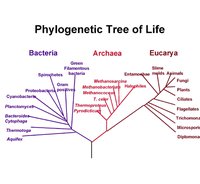
The Tree of Life representing the connections among all organisms has
become
an icon of evolutionary biology. But recent analyses of completely
sequenced
genomes and the discovery that horizontal gene transfer (HGT) has
significantly shaped microbial evolution have challenged the concept of
the
Tree of Life. We have determined the general outline of the tree using
complete genome data from representative prokaryotes and eukaryotes and
using a new genome analysis method that makes it possible to
reconstruct
ancient genome fusions and phylogenetic trees even in the presence of
HGT.
Our analyses indicate that the eukaryotic genome resulted from a fusion
of
two diverse prokaryotic genomes, and therefore at the deepest levels
linking
prokaryotes and eukaryotes, the tree of life is actually a ring of
life. One
fusion partner branches from deep within an ancient photosynthetic
group,
and the other is related to the archaeal prokaryotes. The eubacterial
organism is either a proteobacterium, or a member of a larger
photosynthetic
group that includes the Cyanobacteria and the Proteobacteria.
To join using a videoconferencing system:
Please RSVP to Mike Toillion (mike.toillion@nasa.gov) if you will be joining by Polycom.
To view the slides, connect to http://connect.arc.nasa.gov/uwseminar/
To join using a web browser:
The slides and audio/video for this meeting will be presented using Adobe Connect. To join the meeting, connect to:
http://connect.arc.nasa.gov/uwseminar/
If you are having problems connecting, you can try joining http://connect.arc.nasa.gov/uwseminar/?launcher=false, or rebooting your computer, or try joining from another network.
 Getting Under Europa’s Skin
Getting Under Europa’s Skin Tracing Formation and Evolution of Outer Solar System Bodies Through Stable Isotopes and Noble Gas Abundances
Tracing Formation and Evolution of Outer Solar System Bodies Through Stable Isotopes and Noble Gas Abundances Photosynthesis, a Planetary Revolution
Photosynthesis, a Planetary Revolution Xenon: King of the Gases
Xenon: King of the Gases